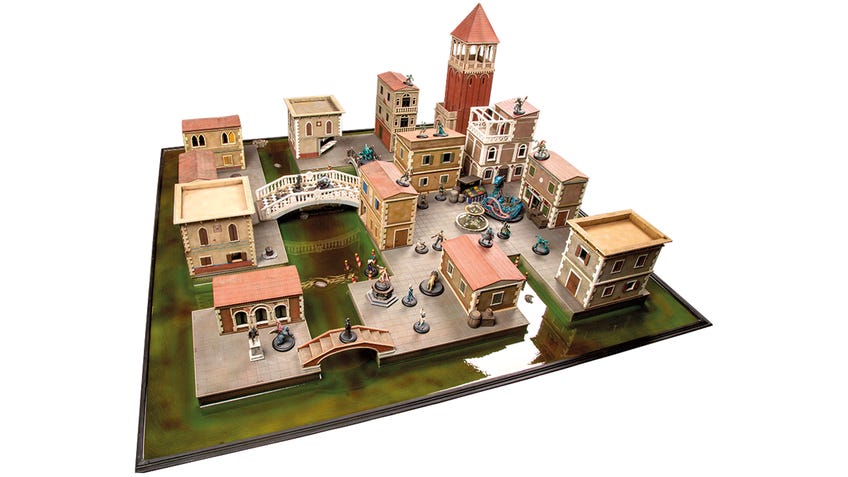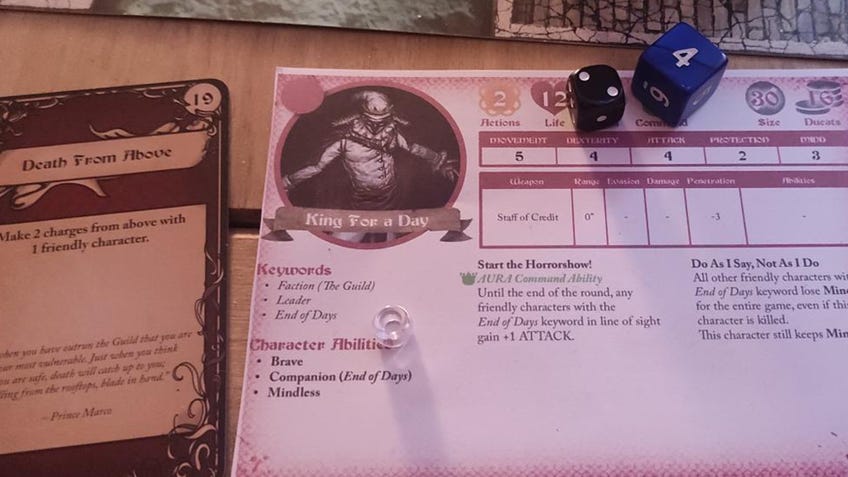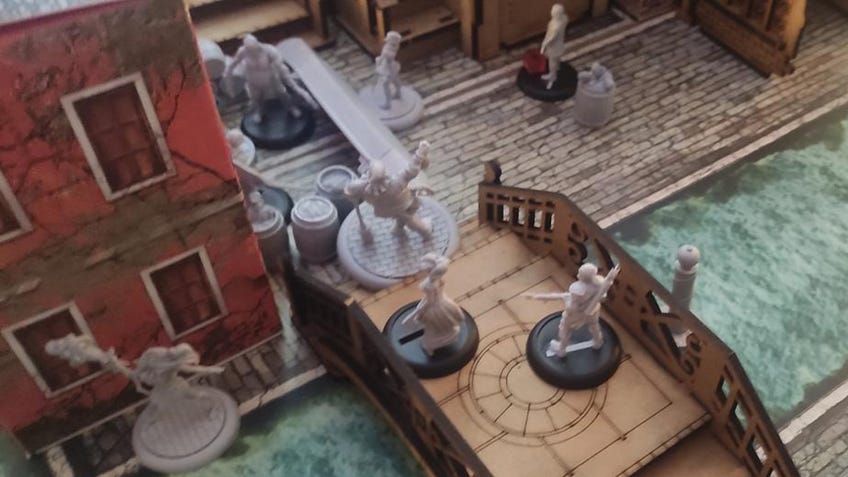Assassin's Creed meets Cthulhu in Venice? Why Carnevale should be your new favourite miniatures game
Venice-ice, baby.
I spent two hours today glueing together a finicky resin ostrich straddled by an Italian clown with the reins between his teeth and a makeshift club in each hand. I do not like building resin models. I especially don’t like finicky ostriches. For miniatures skirmish game Carnevale, though, I will glue together an entire gang’s worth. I plan to, in fact. One of them has a battle trumpet with an ability called ‘Doot’ that causes nearby models to cheer in rapturous glee. He is simply known as the ‘Very Loud Ostrich’ and, although I do not own him, I already love him like a horrible, honking son. Welcome to Venice.
For as long as I can remember, I’ve gazed longingly at beautifully-made boards for Games Workshop’s sadly defunct Mordheim and wistfully sighed: “One day.” Poured, dyed resin waterways. Immaculately constructed thatch-roof cottages. Alleys, marketplaces and bridges. One Carnevale starter set, a few MDF buildings and a smattering of tiny barrels later, and I’m already backflipping off buildings, air-assassinating from railings and drowning my foes in canals. Also, there’s a gondola, but we’ll get to that later. It might not be quite as beautiful as those magnificent boards but, Gesù Cristo, it is some of the most fun I’ve had rolling dice in years. Carnevale turns your own cobbled-together slice of Venice into a character in its own right like few other miniatures games.
Set along the canals and rooftops of a late 18th-century Venice, Carnevale depicts an alternate history where a gaping, eldritch wound has opened up in the sky, bathing Europe in strange magicks. I won’t go too deeply into the lore here, because I won’t do it the same justice as writers Josh Tonkin, David LaPorta and actual-Gav-bloody-Thorpe have in its story-stuffed rules tome, but the high-level aesthetic is 18th-century historical mixed with vaudevillian debauchery, dashes of Dishonored and Assassin’s Creed, and gothic and cosmic horror.

Fighting, acrobatics and other feats are measured in inches and a handful of d10s, with the occasional victorious crit or goofy fumble down to a single destiny die that worms its fated way into every roll. I have seen lowly citizens beat scaly monstrosities to death with billy clubs, and I have seen supposedly agile heroes faceplant and bleed out on a miscalculated jump before achieving anything of note. These rolls aren’t common enough to really factor into your tactics, but they add the lovely possibility of narrative chaos rearing its smirking head. Dice mitigation, and even turn order mitigation, exists in various forms, but whatever number shows up on that destiny die is permanent.
Carnevale turns your own cobbled-together slice of Venice into a character in its own right like few other miniatures games.
Up to four players alternate between activating one model each, so the action is quick. There are also ways to respond to your opponents during their turn, if you’re willing to spend rare will and rarer command points. Get too haphazard, though, and you won’t have many left for everything from boosting dice pools and activating special abilities to casting spells from one of five schools of magic. Yesterday, my opponent’s plague doctor teleported a mind-controlled gorilla with clockwork Da Vinci wings right above my leader. The gorilla plummeted to earth and into base contact with my shocked capo, granting the monkey a free charge attack with a whopping -5 penetration for the air drop, denying me any protection rolls. Ouch.
So, there’s plenty of room for considered, crunchy combos, but Carnevale’s ruleset seems most concerned with supporting its subtitle of a ‘Narrative Skirmish Game’. There are rules for campaigns, including injury tables and levelling, but this narrative aspect is more pronounced in the moment-to-moment. Like tabletop RPG rules, much of Carnevale seems designed to provide answers to questions such as “Can I do this?” or “Oh, this would be cool. Is there a rule for it?” There’s even a rule called ‘Fortune’s Favour’ that lets you reward a will point to your opponent after they pull off a daring move, with a bonus additional will point if they tell the story of what just happened.
Probably my favourite example of this philosophy is chain jumps. Once per activation, a character gets an extra free jump from an obstacle, like a barrel, a bridge railing or the prow of a gondola, providing they jump to that obstacle first. It’s the only free action of its type, and so encourages stringing together creative (and sometimes risky!) acrobatics to get the most out of each activation. Plus, obviously, it’s just cool. What’s more dashing: a cutlass stab? Or a cutlass stab after hopping across a row of gondola poles? Vertical movement, like scaling a building, is as simple as a quick dexterity check. And as long as a character doesn’t run out of action points halfway up a building (which results in a nasty fall), they’re fine to hang from a Pallazio window while they shoot, or jump to another building, or whatever else takes their fancy.

This does present a barrier to entry, however: terrain is basically essential to experience Carnevale at its best. While you could grab a rulebook, some dice and templates, and a couple of gangs (character stats are freely printable online), the two available starter sets are by far the best place to begin if you don’t already have enough scenery. Both contain tiles with canals and cobblestone streets, and card buildings. I’d also highly recommend a few handfuls of scatter terrain - crates, barrels or, honestly, 2p coins - to make sure players are never too far away from a chain jump. Carnevale is at its weakest when it's just two models slugging each other with attack and protection rolls. But a double jump followed by a grapple into a nearby canal? Cinematic joy. Simply moving into base contact with an enemy model always gives a free attack, which keeps the action fast and frequent.
Chain jumps encourage stringing together creative (and sometimes risky!) acrobatics to get the most out of each activation.
Still, you won’t often find games devolving into melee slugfests anyway, because of agendas - secondary objectives that are often the main way to win many scenarios. Sometimes these are secret, or let you double-or-nothing or other special conditions, but the basic idea remains the same: roll on a table or draw cards beforehand, and get a set of feats to pull off during the game. Drown three enemy characters, say. Or make three successful four-inch jumps in a single round. These can result in some utterly baffling turns on both sides, but who are we to know the strange motivations behind the Cult of Dagon, or a drunken clown riding an ostrich?

It’s also not the worst on the wallet, either. In general, publisher TTCombat’s business model is a breath of fresh air. All rules and stats are available online; you only have to buy the models and scenery. Its own line of MDF Streets of Venice buildings are shockingly cheap, too, as long as you’ve got a few hours and some PVA glue to spare. The exception to this is, bafflingly, a single page of advanced rules you can only get by buying the latest book. It’s a cheap, gorgeous book, full of lore and art and campaigns, but this one choice feels antithetical to the otherwise refreshing ethos shown elsewhere. Also, neither of the currently available starter sets contain the updated rules, making the Blood on the Water supplement a must-buy alongside your chosen starter if you want to keep up to date without putting your printer through the ringer.
Admittedly, I fell in love with the game just using the old rules - and it’s safe to say that if those old rules don’t grab you, the new ones won’t either. It’s a symptom of a game that’s clearly between editions, but it’s still an annoyance.
Minor gripes aside, Carnevale is the fastest, funnest, most thematically rich and accessible miniatures game I’ve played in a very long time. So good, in fact, that I wrote this whole article just to send it to everyone I know, instead of talking their ear off over why they should come play it. Also, I’m only realising now I never mentioned those gondolas again. Yes, there are gondolas. You can gondol. There are also gondoliers. They can also gondol, but better. Magnifico.


